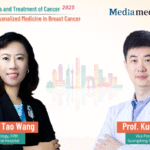
On August 22–23, 2025, the 13th Ludaopei Hematology Conference was grandly held in Beijing, jointly organized by the Beijing Health Promotion Association and the Guangzhou Kapok Oncology and Rare Disease Foundation, and hosted by the Beijing Ludaopei Hematology Institute. The meeting brought together leading experts in hematology worldwide, focusing on hematopoietic stem cell transplantation, cellular therapy, and precision treatment of hematologic malignancies. Over a thousand participants attended this high-level academic event.
During the conference, Professor Sun Ruijuan from Hebei Yanda Ludaopei Hospital delivered an insightful presentation on allogeneic hematopoietic stem cell transplantation (HSCT) for infant leukemia. In an exclusive interview with Oncology Frontier – Hematology Frontier, Professor Sun shared her in-depth perspectives on the clinical challenges, donor selection, and long-term outcomes of transplantation in this unique patient population.
Part 1: Clinical Challenges in Infant HSCT
Q: Infant leukemia patients face unique challenges due to their age and immature organ function. Based on your clinical experience, what are the main difficulties in HSCT for these patients, and how are they currently managed?
Prof. Sun Ruijuan: HSCT in infant leukemia requires special attention to several key aspects.
First, donor selection is particularly critical. Because infant leukemia often coexists with congenital immunodeficiency backgrounds, it is essential to avoid donors carrying similar pathogenic genetic defects, thereby minimizing transplant-related risks.
Second, the conditioning regimen poses significant challenges. Infants have low body weight and are unable to clearly express discomfort. Therefore, careful monitoring of vital signs and meticulous nursing are indispensable for timely adjustments to the regimen. Drug administration—including fluid balance and infusion rates—must be precisely tailored to body weight and organ function status.
Third, during the post-transplant phase, clinicians must closely monitor a wide range of subtle clinical indicators: skin changes, stool consistency, daily milk intake, urine color and volume, and overall fluid balance. These nonspecific but critical signs provide an overall picture of the patient’s condition and guide real-time therapeutic adjustments.
Part 2: Donor Selection Strategies
Q: Donor choice is a decisive factor in HSCT outcomes. Are there any special considerations for infant leukemia patients? How do you balance related versus unrelated donors?
Prof. Sun Ruijuan: The principles of donor selection for infants are broadly similar to those for adults, but infants’ lower body weight also allows for the option of cord blood transplantation.
For infants in sustained remission before transplantation, the preferred donor is a fully HLA-matched sibling (10/10). If unavailable, a 10/10 or 9/10 matched unrelated donor can be considered. Cord blood with a 12/12 HLA match is also a feasible alternative.
When parents or siblings are considered as donors, we must ensure they do not carry the same congenital immunodeficiency mutations as the patient, in order to avoid hereditary risks.
Part 3: Long-Term Outcomes and Follow-Up
Q: Long-term survival and quality of life after transplantation are major concerns. Could you share the outcomes observed in your patients and your team’s follow-up strategies?
Prof. Sun Ruijuan: Long-term management in infant HSCT differs significantly from adults. These patients require prolonged follow-up.
Post-transplant, many infants experience delayed growth and development compared to healthy peers, even after immune reconstitution. In our clinical practice, we often see height and weight developing at a slower pace; however, after discontinuation of immunosuppressants, gradual catch-up growth is possible.
Fertility preservation is another challenge. Transplant conditioning may impair ovarian and uterine development in female patients, leading to delayed menarche, amenorrhea, or premature ovarian failure. To mitigate this, conditioning intensity must be individualized. For high-risk or relapsed/refractory leukemia, the priority is life-saving, and growth protection may be difficult to achieve. For high-risk but chemotherapy-sensitive patients, reduced-intensity regimens or organ-sparing drug combinations may be considered.
Currently, HSCT is mainly indicated for high-risk and relapsed/refractory infant leukemia. For low- or intermediate-risk patients, frontline strategies usually include combination chemotherapy, targeted therapy, or cellular immunotherapy, with long-term monitoring to determine relapse risk before deciding on transplantation. Careful timing and patient selection remain essential.
Expert Profile

Sun Ruijuan, MD Director, Department of Hematopoietic Stem Cell Transplantation, Ludaopei Hospital
- Member, Committee on Inborn Cellular Disorders, Chinese Medical Doctor Association
- Member, Cord Blood Application Committee, Chinese Maternal and Child Health Association
- Member, Langfang Anti-Cancer Association, Hebei Province
With over 20 years of clinical experience in HSCT, Dr. Sun has successfully completed more than 1,000 allogeneic transplants, treating patients from 7 months to 69 years of age. She is highly experienced in managing acute and chronic GVHD, severe infections, and post-transplant complications, and is recognized for her expertise in immunotherapy for relapse prevention.
She participated in several national firsts, including:
- The first autologous cord blood transplant for pediatric severe aplastic anemia in China
- The first HSCT for XIAP-related hemophagocytic lymphohistiocytosis in China
- Multiple HSCTs for congenital dyskeratosis congenita
Dr. Sun has presented her work at major international meetings, including APBMT, EBMT, TCT, and ASH, contributing significantly to the global exchange of HSCT expertise.


